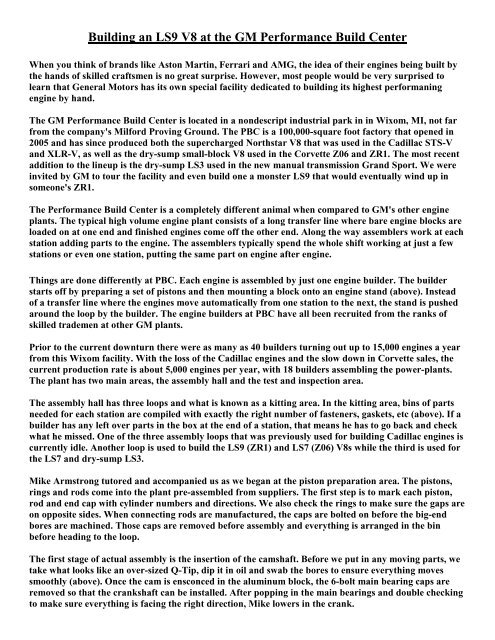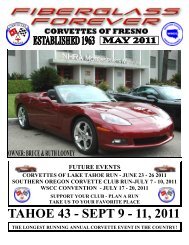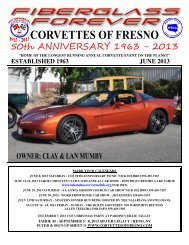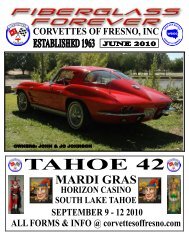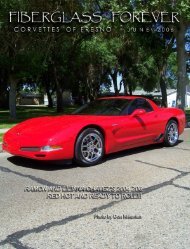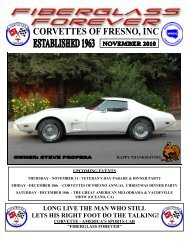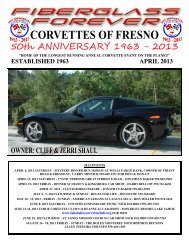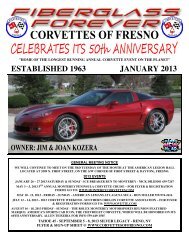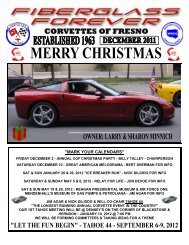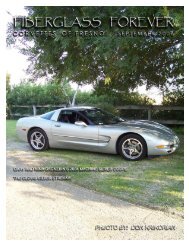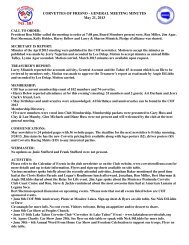corvettes of fresno - Description: Description: Description ...
corvettes of fresno - Description: Description: Description ...
corvettes of fresno - Description: Description: Description ...
Create successful ePaper yourself
Turn your PDF publications into a flip-book with our unique Google optimized e-Paper software.
Building an LS9 V8 at the GM Performance Build Center<br />
When you think <strong>of</strong> brands like Aston Martin, Ferrari and AMG, the idea <strong>of</strong> their engines being built by<br />
the hands <strong>of</strong> skilled craftsmen is no great surprise. However, most people would be very surprised to<br />
learn that General Motors has its own special facility dedicated to building its highest performaning<br />
engine by hand.<br />
The GM Performance Build Center is located in a nondescript industrial park in in Wixom, MI, not far<br />
from the company's Milford Proving Ground. The PBC is a 100,000-square foot factory that opened in<br />
2005 and has since produced both the supercharged Northstar V8 that was used in the Cadillac STS-V<br />
and XLR-V, as well as the dry-sump small-block V8 used in the Corvette Z06 and ZR1. The most recent<br />
addition to the lineup is the dry-sump LS3 used in the new manual transmission Grand Sport. We were<br />
invited by GM to tour the facility and even build one a monster LS9 that would eventually wind up in<br />
someone's ZR1.<br />
The Performance Build Center is a completely different animal when compared to GM's other engine<br />
plants. The typical high volume engine plant consists <strong>of</strong> a long transfer line where bare engine blocks are<br />
loaded on at one end and finished engines come <strong>of</strong>f the other end. Along the way assemblers work at each<br />
station adding parts to the engine. The assemblers typically spend the whole shift working at just a few<br />
stations or even one station, putting the same part on engine after engine.<br />
Things are done differently at PBC. Each engine is assembled by just one engine builder. The builder<br />
starts <strong>of</strong>f by preparing a set <strong>of</strong> pistons and then mounting a block onto an engine stand (above). Instead<br />
<strong>of</strong> a transfer line where the engines move automatically from one station to the next, the stand is pushed<br />
around the loop by the builder. The engine builders at PBC have all been recruited from the ranks <strong>of</strong><br />
skilled trademen at other GM plants.<br />
Prior to the current downturn there were as many as 40 builders turning out up to 15,000 engines a year<br />
from this Wixom facility. With the loss <strong>of</strong> the Cadillac engines and the slow down in Corvette sales, the<br />
current production rate is about 5,000 engines per year, with 18 builders assembling the power-plants.<br />
The plant has two main areas, the assembly hall and the test and inspection area.<br />
The assembly hall has three loops and what is known as a kitting area. In the kitting area, bins <strong>of</strong> parts<br />
needed for each station are compiled with exactly the right number <strong>of</strong> fasteners, gaskets, etc (above). If a<br />
builder has any left over parts in the box at the end <strong>of</strong> a station, that means he has to go back and check<br />
what he missed. One <strong>of</strong> the three assembly loops that was previously used for building Cadillac engines is<br />
currently idle. Another loop is used to build the LS9 (ZR1) and LS7 (Z06) V8s while the third is used for<br />
the LS7 and dry-sump LS3.<br />
Mike Armstrong tutored and accompanied us as we began at the piston preparation area. The pistons,<br />
rings and rods come into the plant pre-assembled from suppliers. The first step is to mark each piston,<br />
rod and end cap with cylinder numbers and directions. We also check the rings to make sure the gaps are<br />
on opposite sides. When connecting rods are manufactured, the caps are bolted on before the big-end<br />
bores are machined. Those caps are removed before assembly and everything is arranged in the bin<br />
before heading to the loop.<br />
The first stage <strong>of</strong> actual assembly is the insertion <strong>of</strong> the camshaft. Before we put in any moving parts, we<br />
take what looks like an over-sized Q-Tip, dip it in oil and swab the bores to ensure everything moves<br />
smoothly (above). Once the cam is ensconced in the aluminum block, the 6-bolt main bearing caps are<br />
removed so that the crankshaft can be installed. After popping in the main bearings and double checking<br />
to make sure everything is facing the right direction, Mike lowers in the crank.


